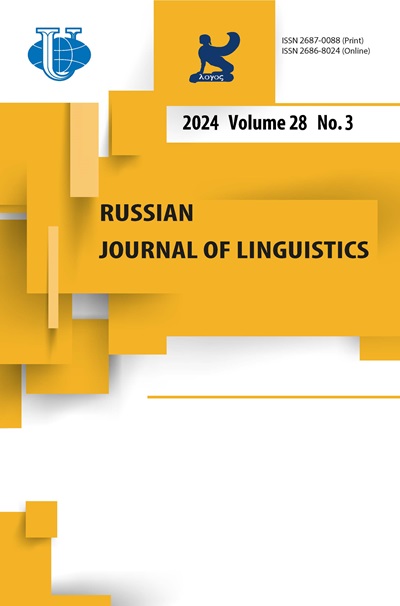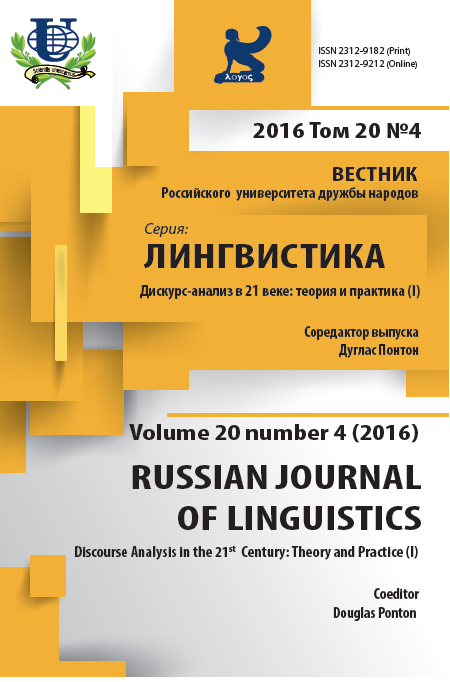“Let Me Tell You...”: Audience Engagement Strategies in the Campaign Speeches of Trump, Clinton, and Sanders
- Authors: Quam J.1, Ryshina-Pankova M.1
-
Affiliations:
- Georgetown University
- Issue: Vol 20, No 4 (2016): Discourse Analysis in the 21st Century: Theory and Practice (I)
- Pages: 140-160
- Section: Articles
- URL: https://journals.rudn.ru/linguistics/article/view/15153
- DOI: https://doi.org/10.22363/2687-0088-15153
Cite item
Full Text
Abstract
Throughout the 2016 campaign, presidential candidate Donald Trump surprised observers with his ability to maintain his popularity in the face of unorthodox and often offensive statements. Trump likely bolstered his electoral chances by appealing to a large segment of voters with whom other candidates failed to align themselves. To quote one news anchor, “People tried to attack Trump; it just didn’t work - voters liked him anyway”. As previous work by Miller (2002; 2004) has shown, systemic functional linguistic (SFL) analysis (Halliday & Matthiessen, 2004) can illuminate particular strategies politicians employ to strengthen their arguments and exhort their audiences to join their efforts. In this paper, we employ the SFL-based Engagement framework (White, 2003; Martin & White, 2005) to examine ways in which the 2016 presidential candidates aligned themselves with their audiences. Our analysis of the speeches of Donald Trump, Hillary Clinton, and Bernie Sanders reveals markedly different patterns of interaction with the voters in terms of ways expansive and contractive dialogic strategies are used, an intended audience is identified and thematized, and shared assumptions are made. While Trump makes his arguments in a highly constrained dialogic space, taking the agreement with the audience for granted, his opponents often employ a mix of contractive and expansive argumentative strategies and make more explicit overtures to the audiences whose perspectives they share. This study offers insights as to how each candidate identifies and addresses his or her ideological sympathizers or opponents and exhorts the former to intensify their support.
About the authors
Justin Quam
Georgetown University
Email: jq89@georgetown.edu
37th and O Streets, N.W., Washington D.C. 20057, USA
Mariana Ryshina-Pankova
Georgetown University
Email: ryshinam@georgetown.edu
37th and O Streets, N.W., Washington D.C. 20057, USA
References
- Anderson, K.V. (2002). From spouses to candidates: Hillary Rodham Clinton, Elizabeth Dole, and the gendered office of US president. Rhetoric & Public Affairs, 5(1), 105-132
- Austin, J. L. (1975). How to do things with words. Oxford University Press
- Barreto, M.A., Redlawsk, D., & Tolbert, C.J. (2009). Measuring respondent agreement/disagreement with framing experiments: Race, religion and voting against Barack Obama in 2008. Paper presented at the Annual Meeting of the American Political Science Association, September 3-6, 2009, Toronto, ON, Canada
- Bierman, N. (2016, July 20). Here are the places where Donald Trump and the Republican Party disagree. Los Angeles Times. Accessed 10 December 2016 at http://www.latimes.com/politics/ la-na-pol-trump-gop-positions-20160720-snap-htmlstory.html
- Bligh, M., Merolla, J., Schroedel, J.R., & Gonzalez, R. (2010). Finding her voice: Hillary Clinton’s rhetoric in the 2008 presidential campaign. Women’s Studies, 39(8), 823-850
- Capone, A. (2010). Barack Obama’s South Carolina speech. Journal of Pragmatics, 42(11), 2964-2977
- Catalano, T. (2011). Barack Obama: A semiotic analysis of his Philadelphia speech. Issues in Political Discourse Analysis, 8(1), 47-74
- Chang, G.C., & Mehan, H.B. (2006). Discourse in a religious mode: The Bush administration’s discourse in the War on Terrorism and its challenges. Pragmatics, 16(1), 1-23
- Clark, C. (2007, June 25). Drew Westen’s ‘Political Brain’ gets Democratic candidates thinking. Emory Report. Accessed 9 December 2016 at https://www.emory.edu/EMORY_REPORT/erarchive/ 2007/June/June%2025/Westen.htm
- Degani, M. (2016a). Endangered intellect: a case study of Clinton vs Trump campaign discourse. Iperstoria - Testi Letterature Linguaggi, 8, 131-145
- Degani, M. (2016b). An investigation of American opposing political cultures in the speeches of Barack Obama and John McCain. Accessed 10 December 2016 at http://edipuglia.it/wp-content/ uploads/2016/08/Degani.pdf
- Dreher, R. (2016, July 22). Trump: Tribune of poor white people. The American Conservative. Accessed 3 September 2016 at http://www.theamericanconservative.com/dreher/trump-us-politics-poor-whites
- Fallows, J. (2016, October). When Donald meets Hillary. The Atlantic. Accessed 24 September 2016 at http://www.theatlantic.com/magazine/archive/2016/10/who-will-win/497561/
- Gallup. (2016). Americans believe 2015 was record-warm, but split on why. Gallup. Accessed 13 December 2016 at http://www.gallup.com/poll/190319/americans-believe-2015-record-warm-split-why.aspx?g_source=CATEGORY_CLIMATE_CHANGE&g_medium=topic&g_campaign=tiles
- Golshan, T. (2016, August 18). Donald Trump’s strange speaking style, as explained by linguists. Vox. Accessed 3 September 2016 at http://www.vox.com/2016/8/18/12423688/donald-trump-speech-style-explained-by-linguists
- Hall, K., Goldstein, D.M., & Ingram, M.B. (2016). The hands of Donald Trump: Entertainment, gesture, spectacle. HAU: Journal of Ethnographic Theory, 6(2), 71-100
- Halliday, M.A.K., & Matthiessen, C.M.I.M. (2004). An introduction to functional grammar. London: Arnold
- Hoel, N.S. (2016). Challenging social class in American political discourse: Bernie Sanders, Occupy Wall Street, and the new discourse of inequality. (Unpublished MA thesis). Oslo: University of Oslo
- Knoll, B.R., Redlawsk, D.P., & Sanborn, H. (2011). Framing labels and immigration policy attitudes in the Iowa caucuses: “Trying to out-Tancredo Tancredo”. Political Behavior, 33(3), 433-454
- Lexicon Valley. (2015, July 31). Help us diagram this sentence by Donald Trump! Slate Magazine. Accessed 10 December 2016 at http://www.slate.com/blogs/lexicon_valley/2015/07/31/donald_ trump_this_run_on_sentence_from_a_speech_in_sun_city_south_carolina.html
- Iyengar, S. (2005). Speaking of values: The framing of American politics. The Forum, 3(3), 1-8
- Kruse, M., & Weiland, N. (2015, May 5). Donald Trump’s greatest self-contradictions. Politico. Accessed 3 September 2016 at http://www.politico.com/magazine/story/2016/05/donald-trump-2016-contradictions-213869
- Lakoff, G. (2004). Don’t think of an elephant! Know your values and frame the debate. the essential guide for progressives, including post-election updates. Chelsea, VT: Chelsea Green Publishing
- Lakoff, G. (2016, July 23). Understanding Trump. [Blog post]. Accessed 13 December 2016 at https://georgelakoff.com/2016/07/23/understanding-trump-2
- Liberman, M. (2016a, August 16). The rhetorical style of spontaneous speech. [Blog post]. Language Log. Accessed 3 September 2016 at http://languagelog.ldc.upenn.edu/nll/?p=27515
- Liberman, M. (2016b, August 15). The em-dash candidate. [Blog post]. Language Log. Accessed 3 September 2016 at http://languagelog.ldc.upenn.edu/nll/?p=27479
- Libit, D. (2016, August 15). Transcribers’ agony: Frustrated not by what Trump says but how he says it. CNBC. Accessed 13 December 2016 at http://www.cnbc.com/2016/08/15/transcribers-agony-frustrated-not-by-what-trump-says-but-how-he-says-it.html
- Malkmus, T. (2013). “Marco and micro, quantitative and qualitative: An integrative approach for analyzing (election night) speeches”. In Discourse approaches to politics, society and culture. Analyzing genres in political communication: Theory and practice (pp. 267-296). Philadelphia/Amsterdam: John Benjamins
- Martin, J.R., & White, P.R.R. (2005). The language of evaluation. London: Palgrave Macmillan
- Miller, D.R. (2002). Multiple judicial opinions as specialized sites of ENGAGEMENT: conflicting paradigms of valuation and legitimation in Bush v. Gore 2000. In M. Gotti, D. Heller, & M. Dossena (Eds.), Conflict and negotiation in specialized texts (pp. 119-141). Bern: Peter Lang
- Miller, D.R. (2004). “...to meet our common challenge”: ENGAGEMENT strategies of alignment and alienation in current US international discourse. Textus, 18(1), 39-62
- News Editor. (2016, May 4). Transcript: Donald Trump’s remarks after winning the Indiana primary - Part 1 | What The Folly?!. Whatthefolly.com. Accessed 14 December 2016 at http://www.whatthefolly.com/2016/05/04/transcript-donald-trumps-remarks-after-winning-the-indiana-primary-part-1
- October 5, 1988 Debate Transcripts. (2015). Commission on Presidential Debates. Accessed 14 December 2016 at http://www.debates.org/index.php?page=october-5-1988-debate-transcripts
- Parker, A., & Haberman, M. (2016, May 28). Donald Trump’s campaign stumbles as it tries to go big. The New York Times. Accessed 10 December 2016 athttp://www.nytimes.com/2016/05/28/ us/politics/donald-trump-campaign.html
- Pennebaker, J.W., Slatcher, R.B., & Chung, C.K. (2005). Linguistic markers of psychological state through media interviews: John Kerry and John Edwards in 2004, Al Gore in 2000. Analyses of Social Issues and Public Policy, 5(1), 197-204
- Pullum, G. (2015, August 5). Trump’s aphasia. [Blog post]. Language Log. Accessed 3 September 2016 at http://languagelog.ldc.upenn.edu/nll/?p=20490
- Rappeport, A., & Haberman, M. (2016, June 30). How Donald Trump keeps changing his mind on abortion, torture and banning Muslims. The New York Times. Accessed 3 September 2016 at http://www.nytimes.com/2016/06/30/us/politics/donald-trump-flip-flop.html
- Reilly, K. (2016). Read Hillary Clinton’s historic primary victory speech. TIME.com. Accessed 14 December 2016 at http://time.com/4361099/hillary-clinton-nominee-speech-transcript
- Savoy, J. (2016). Analysis of the style and the rhetoric of the 2016 US presidential primaries. Accessed 13 December 2016 at https://www.researchgate.net/profile/Jacques_Savoy/publication/ 310674208_Analysis_of_the_Style_and_the_Rhetoric_of_the_2016_US_Presidential_Primaries/ links/58353f1908ae102f07397219.pdf
- Silver, N. (2015, Nov. 23). Dear media, stop freaking out about Donald Trump’s polls. FiveThirtyEight. Accessed 10 December 2016 at http://fivethirtyeight.com/features/dear-media-stop-freaking-out-about-donald-trumps-polls
- Slatcher, R.B., Chung, C.K., Pennebaker, J.W., & Stone, L.D. (2007). Winning words: Individual differences in linguistic style among US presidential and vice presidential candidates. Journal of Research in Personality, 41(1), 63-75
- Sparks, A. (2009). Minstrel politics or “He speaks too well”: Rhetoric, race, and resistance in the 2008 presidential campaign. Argumentation and Advocacy, 46(1), 21-38
- Washington Post Staff. (2016a, February 20). The transcript of Bernie Sanders’s victory speech. The Washington Post. Accessed 14 December 2016 at https://www.washingtonpost.com/ news/post-politics/wp/2016/02/10/the-transcript-of-bernie-sanderss-victory-speech/?utm_ term=.5a96b1148168
- Washington Post Staff. (2016b, February 20). Transcript: Trump’s victory speech after the South Carolina GOP primary. The Washington Post. Retrieved 13 December 2016, from https://www.washingtonpost.com/news/post-politics/wp/2016/02/20/transcript-donald-trumps-victory-speech-after-the-south-carolina-gop-primary/?utm_term=.808a763f71b4
- Westen, D. (2008). The political brain: The role of emotion in deciding the fate of the nation. Public Affairs
- White, P.R.R. (2003). Beyond modality and hedging: A dialogic view of the language of intersubjective stance. Text, 23(2), 259-284
- White, P.R.R. (2015) Appraisal and the resources of intersubjective stance. Accessed 12 April 2016 at http://languageofevaluation.info/appraisal/engagement/engagementlatest.doc

















